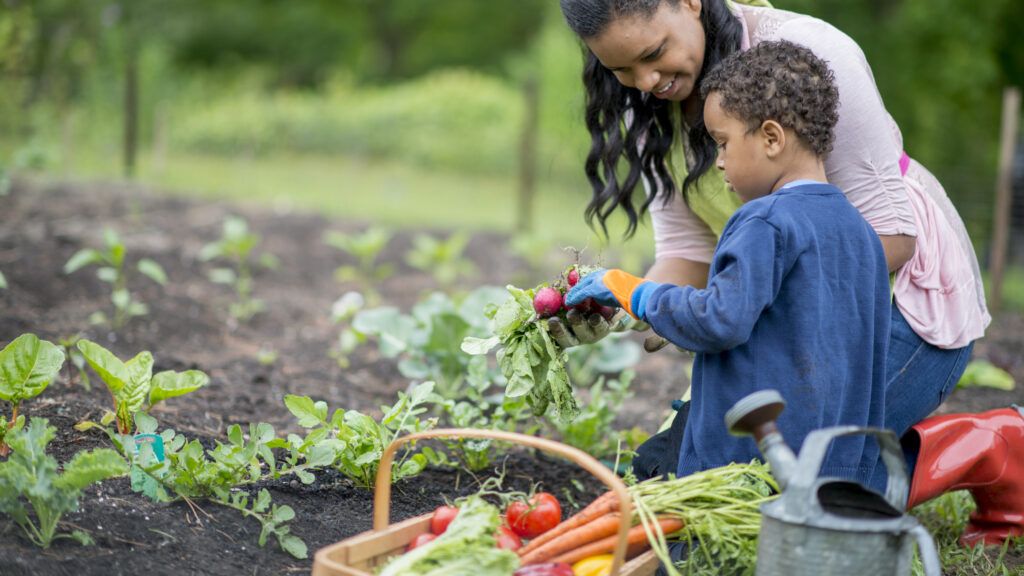Instead of breaking the bank, break ground on a family garden this spring. Not only is gardening a relaxing activity that can bring the family together, if you all play a role, you’ll also save money by growing your own food.
Most of the vegetables on this list require little more than lots of sunshine and regular watering. Find seeds at your local garden store or order through the website of a respected seller like Burpee. The Old Farmer’s Almanac is available online and provides comprehensive guides to growing different fruits and vegetables; it’s a great resource for beginner gardeners. Get your start with these easy-to-grow herbs and vegetables.
1) Green Beans
Why They Belong in Your Garden: Green beans are a great source of vitamins. You can toss them in a quick weeknight stir fry or add them to a casserole. If you and your family are not a fan of green beans, peas make for an easy alternative.
When to Plant: Wait for the last frost to pass, then choose a sunny patch of the garden for your green beans. Don’t have yard? No problem. Green beans grow well in containers too.
When to Harvest: Your green beans will be ready for their new home on your plate in seven to eight weeks. Don’t let your beans linger on the vine, they’ll get old, coarse and inedible. Pluck the pods as soon as your plants produce them.
2) Carrots
Why They Belong in Your Garden: Carrots are a sweet, healthy treat with a satisfying crunch. Nantes are one of the most popular varieties of carrots because they grow fast and aren’t finicky about the climate you grown them in—you can even grow them indoors. If you have a bountiful crop, carrots, like cucumbers, pickle well.
When to Plant: Get your carrot seeds in the ground a couple of weeks before the last frost.
When to Harvest: Your carrots will be ready for you to munch on them in 10 to 11 weeks. You’ll know it’s time to pull them from the ground when you see a good half to three-fourths inch of orange carrot push up from the dirt.
3) Sweet Peppers
Why They Belong in Your Garden: You don’t have to grow an orange tree to help your family bump up their vitamin C intake. Bell peppers pack more vitamin C than oranges. If you like a little heat, spicier varieties of peppers are also easy to grow. This veggie is beloved by gardeners because most pests avoid it.
When to Plant: You’ll want to give your bell pepper seeds a two-month head start indoors before planting them outside.
When to Harvest: Bell peppers are ripe for the picking about two to three months after you plant them. For green bell peppers, harvest as soon as your peppers are about as tall as your palm. Left on the vine, green bell peppers will turn red and red bell peppers will turn yellow or orange – they’re tasty at any stage.
4) Tomatoes
Why They Belong in Your Garden: Nothing like a homegrown tomato straight off the vine—truly one of life’s simple pleasures. Tomatoes produce a plentiful crop, but you’ll have to watch out for pests and backyard thieves like squirrels who also enjoy a juicy, ripe tomato.
When to Plant: Tomatoes, like bell peppers, should be planted indoors two-months before you transfer them to your garden. When it comes to tomatoes, don’t slack on the watering.
When to Harvest: You’ll have to wait two to three months to sink your teeth into your tomatoes. You’ll likely spend two weeks harvesting your tomatoes as they tend to yield a generous crop. You’ll know yours are ready to come off the vine when they’re fully red and if they give a little when you squeeze them.
5) Zucchini
Why They Belong in Your Garden: Zucchini is excellent source fiber and nutrients. This is another vegetable that’s a high producer. Bonus: Zucchini blossoms are delicious fried up and can often be hard to find at the grocery store.
When to Plant: Getting a late start on the garden? Summer squash like zucchini can go in the ground late spring to mid-summer. Be sure to plant your summer squash where it will get ample sun.
When to Harvest: Give them two months and then it’s time to go grab your zucchini from the garden. They’ll be ready less than a week after they flower.
6) Onions
Why They Belong in Your Garden: Your family will find many yummy uses for this grocery store staple. Homegrown onions go straight from the ground, so you can eat them with their freshest and most delicious. When choosing which type of onion to grow, stick with “long-day” if you live in the North and “short-day” if you live down South.
When to Plant: Early spring is the time to get your onion crop growing. Cut a few corners and increase your success rate by using dried onion bulbs, also known as an “onion set.” Onions like it in the sun with fertilizer and a little water.
When to Harvest: The hardest part about growing onions is being patient. Your onions will need about three to six-and-half months of grow time. They’ll be ready soon after their leaves begin to droop.
7) Herbs
Why They Belong in Your Garden: Fresh herbs from the grocery store can get expensive fast and go to waste if you don’t use them right away. Growing your own herbs allows you to trim what you need, when you need it. A flavorful dinner doesn’t have to feel like a luxury. You can grow your herbs indoors, in your garden, or even on your balcony. Herbs that are easy to grow are basil, rosemary, thyme, parsley, and mint.
When to Plant: Once spring has arrived and they days have become longer, it’s time to plant your windowsill herb garden. Be sure to choose a sill that gets lots of sunlight. If you’re planting your herbs outside, you’ll want to get started as soon as the weather turns nice. If you live some place where the temperature climbs into the 90s, bring your herbs in before summer hits – they don’t like excessive heat.
When to Harvest: Harvest time will vary by herb, but generally your herbs are ready to spice up your meal once they’re three to six inches tall. At this point, they’ll begin to resemble the herbs you’re used to buying at the grocery.
Start your garden now and in a few months, you and your family will be reaping the rewards—in your bank accounts and your bellies.




